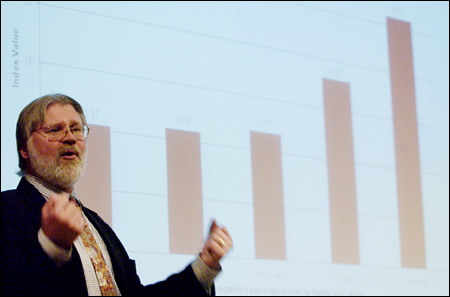Segregation talk kicks off population lecture series
Housing market rife with racial stereotyping

Deep and persistent racial segregation remains a fact of American life and leads to a host of social ills and health concerns that perpetuate stereotypes and create a vicious cycle keeping many African Americans trapped in inner-city neighborhoods.
That was the contention Monday (Oct. 20) of Princeton University Professor Douglas Massey, co-author of “American Apartheid” and an expert on racial segregation in America. Massey was the inaugural speaker in a new lecture series on population issues, sponsored by Provost Steven Hyman and School of Public Health Dean Barry Bloom.
In the next lecture, Ron Lee of the University of California, Berkeley, will discuss rethinking the evolutionary theory of aging. The lecture will be Nov. 14 at 3:30 p.m. in William James Hall, Room 1.
Massey, who delivered his talk before about 60 in William James Hall’s basement lecture hall, described first the persistent segregation that still marks American society, as well as the poverty and violence that is associated with segregated neighborhoods. He also outlined the concept of “allostatic load,” the body’s response to the stress resulting from neighborhood violence and disorder.
Putting the two together, Massey said, may provide a new factor to combine with social factors in explaining the cycle of poverty that plagues the urban African-American community. It may also help explain the associated physical ills, such as higher incidences of asthma, diabetes, obesity, and low-birth-weight babies that disproportionately affect those communities.

Despite gains in recent decades, Massey said, America’s large urban areas remain only slightly less segregated than South Africa during apartheid. Forty-one percent of black Americans live in conditions he described as “hypersegregation,” in all-black, high-density neighborhoods near other all-black neighborhoods. Another 18 percent of African Americans, he said, live in conditions of high segregation, while 40.5 percent live in low to moderate segregation.
In addition, he said, the gains of recent decades have only slightly decreased the segregation that most African Americans live in.
“The United States has been and remains a very segregated society,” Massey said.
Massey cited a variety of studies exploring the roots of the problem, discarding assertions that class and poverty lie at segregation’s heart. Data from 1990 show that African Americans making an average of $50,000 per year live in more segregated neighborhoods than do poorer Latinos and Asians.
Surveys of white attitudes provide a clue as to what’s going on, Massey said, showing that whites prefer to live in neighborhoods with a majority of whites. Further, 20 percent of whites said their ideal neighborhood is all white, and 25 percent said their ideal neighborhood would include no blacks.
“For a quarter of white Americans, if the world operated according to their preferences, their neighborhood would include no blacks,” Massey said. “Zero.”
The largest reasons given for excluding blacks, Massey said, are stereotypical features of blacks that persist among some whites, including being prone to violence and laziness, lacking intelligence, and a tendency toward living in broken families.
“There’s quite a bit of good evidence that in the year 2000 there existed a reservoir of anti-black stereotyping that gets translated into the housing market,” Massey said.
Massey tested the effect of stereotyping on housing by having students call prospective landlords, using the same script and using white middle-class English, black-accented English, and black English vernacular. The results, he said, show that a white man would be told about an available apartment 75 percent of the time, while a black woman speaking black vernacular, who fared worst in the study, would be told of an available apartment only 38 percent of the time.
Further, Massey said, the study showed that modern technology can abet landlords in screening prospective renters, as 45 percent of calls were answered by voicemail, letting the landlord choose which calls to return.
Segregated housing markets concentrate poverty and its associated social ills, Massey said. Because of this, a substantial number of African Americans are exposed to high levels of violence and other forms of social disorder, such as graffiti and prostitution.
This environment, he said, has been shown to lead to high levels of stress. That stress, he said, has physical effects termed the allostatic load. The stress response includes things like higher levels of adrenalin, a higher heart rate, and the release of glucose and endorphins into the body.
Those physical changes are intended to help the body meet a short-term threat, but can have longer-term harmful effects when extended over a long period. Included are long-term health effects among blacks that have never been explained, Massey said, such as high blood pressure, arterial plaques, higher risk of obesity, and diabetes.
Massey said the allostatic load connection has not been adequately studied, though he outlined work he is planning in connection with the Adolescent Health Study, which includes 15,000 participants.




